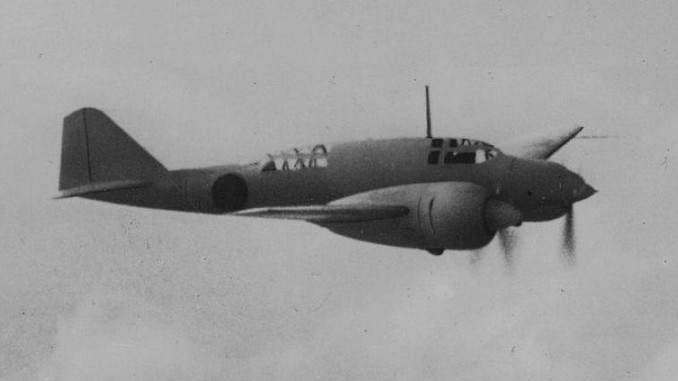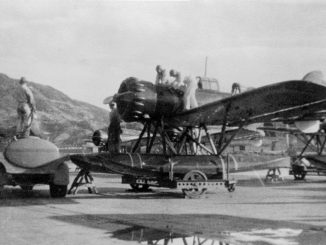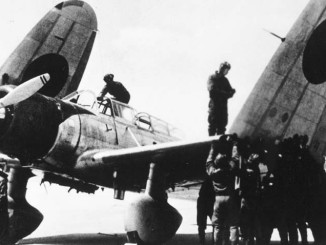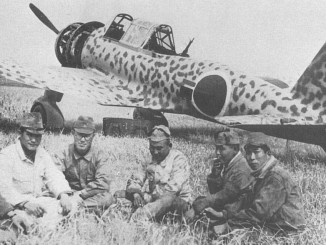
In December 1937 the Japanese Army began a process to replace the Ki-15 reconnaissance aircraft which was proving to be so capable during the China Incident. The specifications were relatively liberal, with the requirement simply to produce an aircraft with sufficient speed and endurance to outrun any fighter aircraft then in service or development. This allowed the Mitsubishi design team under Tomio Kubo to come up with an imaginative design for a twin-engine aircraft with a very aerodynamic shape, which became the Mitsubishi Ki-46. This aircraft took to the air for the first time in November 1939.
The two engines were Mitsubishi Ha-26s with specially designed cowls that greatly reduced drag. The fuselage was very slim and likewise streamlined, but still retained enough space for the two crew and a single defensive machine with which to fend off any fighter that was lucky enough to get close. Later in the war it was realised that the Ki-46 would make a good interceptor against high-flying American bombers, so versions with a 37mm cannon in a “shräge muzik” configuration were stationed in the Home Islands. Here they had numerous encounters with the giant B-29s that were firebombing Japanese cities.
The Mitsubishi Ki-46 first saw action in China during 1941. Several of the type carried out clandestine reconnaissance missions before the opening of hostilities in December 1941, overflying Allied bases in Malaya and the Philippines. As the Japanese offensive unfolded throughout the Southwest Pacific Ki-46s were at the forefront, reconnoitring bases and bringing back valuable information on Allied strength.
Like most Japanese aircraft the Ki-46 was lightly armoured and vulnerable to any Allied fighter that could get within range, and as more powerful fighters became available the aircraft became far more vulnerable. Still, it remained a very capable aircraft and continued to play a role through the closing months of the war, even outperforming its intended replacement – the Tachikawa Ki-70.
In 1942 the Ki-46 was assigned the Allied Reporting Name “Dinah”.
Mitsubishi Ki-46 Type 100 Specifications
| Mitsubishi Ki-46-I | |
| Role | Command Reconnaissance |
| Crew | 2: Pilot and observer |
| Powerplant | 2x Mitsubishi Zuisei 14 (900hp) |
| Speed | 336mph (max) |
| Ceiling | 35,530ft |
| Range | 1,305 miles (internal) |
| Armament | 1x Type 89 7.7mm Machine gun |
| Ordnance | |
| Dimensions | 36ft 1in (length) 48ft 3in (wingspan) 12ft 9in (height) |
| Wing Area | 344 sq.ft. |
| Weight | 7,449lb (empty) 10,631lb (gross) |
| Number produced | 34 |
| Mitsubishi Ki-46-II | |
| Role | Command Reconnaissance |
| Crew | 2: Pilot and observer |
| Powerplant | 2x Mitsubishi Zuisei 21 (1,050hp) |
| Speed | 249mph (cruise) 375mph (max) |
| Ceiling | 35,200ft |
| Range | 1,337 miles (internal) 1,537 miles (external) |
| Armament | 1x Type 89 7.7mm Machine gun |
| Ordnance | |
| Dimensions | 36ft 1in (length) 48ft 3in (wingspan) 12ft 9in (height) |
| Wing Area | 344 sq.ft. |
| Weight | 7,194lb (empty) 11,133lb (gross) 12,787lb (max) |
| Number produced | 1,093 |
| Mitsubishi Ki-46-III | |
| Role | Command Reconnaissance |
| Crew | 2: Pilot and observer |
| Powerplant | 2x Mitsubishi Kinsei 62 (1,560hp) |
| Speed | 391mph (max) |
| Ceiling | 34,450ft |
| Range | 2,485 miles (external) |
| Armament | |
| Ordnance | |
| Dimensions | 36ft 1in (length) 48ft 3in (wingspan) 12ft 9in (height) |
| Wing Area | 344 sq.ft. |
| Weight | 8,446lb (empty) 12,619lb (gross) 14,330lb (max) |
| Mitsubishi Ki-46-III-Kai | |
| Role | Air Defence Fighter |
| Crew | 2: Pilot and observer |
| Powerplant | 2x Mitsubishi Kinsei 62 (1,560hp) |
| Speed | 391mph (max) |
| Ceiling | 34,450ft |
| Range | 1,243 miles (internal) |
| Armament | 1x Ho-204 37mm cannon 2x Ho-1 20mm Cannon |
| Ordnance | |
| Dimensions | 37ft 8in (length) 48ft 3in (wingspan) 12ft 9in (height) |
| Wing Area | 344 sq.ft. |
| Weight | 8,446lb (empty) 13,730lb (gross) |
| Number produced | 609 |
| Mitsubishi Ki-46-IV | |
| Role | Command Reconnaissance |
| Crew | 2: Pilot and observer |
| Powerplant | 2x Mitsubishi Kinsei 62 (1,560hp) |
| Speed | 280mph (cruise) 391mph (max) |
| Ceiling | 36,090ft |
| Range | 2,485 miles (external) |
| Armament | 2x Ho-1 20mm Cannon |
| Ordnance | |
| Dimensions | 36ft 1in (length) 48ft 3in (wingspan) 12ft 9in (height) |
| Wing Area | 344 sq.ft. |
| Weight | 8,840lb (empty) 13,007lb (gross) 14,330lb (max) |
| Number produced | 4 |




Leave a Reply